Commissioning an All-Sky Infrared Camera Array for Detection of Airborne Objects
Abstract
:1. Introduction
1.1. Related Work
1.2. Galileo Project Commissioning Approach
2. Materials and Methods
2.1. The Dalek Infrared Camera Array
2.2. Calibration
2.2.1. Intrinsic Calibration
2.2.2. Removal of Image Non-Uniformities (INUs)
2.2.3. Extrinsic Calibration with ADS-B-Equipped Airplanes
2.2.4. Monitoring Camera Orientation Changes
2.2.5. Thermal Calibration
- Warm or cool down the foam to the target temperature.
- Warm up the camera to 60 °C using an incubator.
- Place it in front of the foam target and capture images at regular intervals while it is cooling down back to room temperature.
- After cooling down the camera to −20 °C with the help of a freezer, place it in front of the target and capture images while it is warming back up to room temperature.
2.2.6. Object Temperature Measurement
2.3. Reconstruction of Aerial Objects Using YOLOv5 and SORT
2.3.1. Datasets for Training and Evaluation
Synthetic Image Dataset
Mixed Synthetic and Real-World Image Dataset
Synthetic Video Dataset
Manually Labeled Real-World Image Dataset
ADS-B-Derived Real-World Dataset
2.3.2. YOLOv5 Benchmark on Manually Labeled Dataset
- Detection errors: True positive (), false positive (), true negative (), and false negative (), in counts.
- Precision (Prcn): The ratio of true positives to the sum of true positives and false positives: .
- Recall (Rcll): The ratio of true positives to the sum of true positives and false negatives: .
- Accuracy: The ratio of correct detections (both true positives and true negatives) to the total number .
- F1-score: The harmonic mean (appropriate for finding the average of two rates) of precision and recall.
2.3.3. Benchmark for SORT on the Synthetic Video Dataset
- Identity switches (IDSs): Also known as association error, it is the count of how many times the reconstructed ID associated with a ground truth trajectory changes, i.e., where objects are incorrectly re-identified as new objects.
- Multiple object tracking accuracy (MOTA): A metric compiling tracking errors over time: .
- Multiple object tracking precision (MOTP): A measure of localization accuracy: , where is the number of matches in frame t, and is the bounding box overlap of target i with its corresponding ground truth box.
- Track quality metrics relative to ground truth trajectories that have been successfully tracked, i.e., have matched Kalman filter predictions, regardless of their predicted ID:
- –
- Mostly tracked (MT): For at least 80% of their life;
- –
- Mostly lost (ML): For less than 20% of their life;
- –
- Partially tracked (PT): For between 20% and 80% of their life;
- –
- Track fragmentations (FMs): A count of how many times a ground truth trajectory goes from tracked to untracked status.
- Identification metrics establishing a one-to-one match between ground truth trajectories and reconstructed trajectories:
- –
- ID precision (IDP): The fraction of reconstructed trajectories which have a match;
- –
- ID recall (IDR): The fraction of true trajectories which have a match;
- –
- ID F1-score (IDF1): The harmonic mean of IDP and IDR.
SORT Parameter Optimization
- frames, which determines how long a reconstructed track can exist without a match before being deleted from the list of current reconstructed track;
- , which requires a track to have a minimum number of consecutive matches before being confirmed;
- , which sets the minimum IoU needed for a detection to be associated with a track;
- , which is a multiplicative factor to scale all bounding box widths and heights proportionally before running SORT.
Benchmark on the Synthetic Video Dataset
3. Commissioning Results
3.1. Basic Checks on Recorded Dataset
3.1.1. Environment Effects on Spatial Distribution of Detection Counts per Camera
3.1.2. Cross-Camera Check
3.1.3. Bounding Box Properties
3.2. Performance Evaluations Using ADS-B-Equipped Aircraft
3.2.1. Evaluation Methodology
- Within a square of side 10 km centered on the observatory;
- Within the field-of-view of at least one camera;
- Above the treeline of the camera from which they should be visible;
- At a time when there is a recording by the relevant camera;
- Are detected by YOLOv5.
3.2.2. Performance Results
3.3. Evaluation Using a Synthetic Dataset
3.4. Unimodal Aerial Census
3.4.1. Toy Outlier Search
Dataset: Reconstructed Trajectories
Toy Outlier Criteria Based on Sinuosity
Manual Examination of High-Sinuosity Trajectories
3.4.2. Likelihood Analysis
4. Discussion
5. Conclusions
Supplementary Materials
Author Contributions
Funding
Data Availability Statement
Acknowledgments
Conflicts of Interest
Appendix A
| Hours | 0 | 1 | 2 | 3 | 4 | 5 | 6 | 7 | 8 | 9 | 10 | 11 | 12 | 13 | 14 | 15 | 16 | 17 | 18 | 19 | 20 | 21 | 22 | 23 |
|---|---|---|---|---|---|---|---|---|---|---|---|---|---|---|---|---|---|---|---|---|---|---|---|---|
| Camera 1 | ||||||||||||||||||||||||
| Summer | ||||||||||||||||||||||||
| Winter | ||||||||||||||||||||||||
| Equinox | ||||||||||||||||||||||||
| Recording | ||||||||||||||||||||||||
| Camera 2 | ||||||||||||||||||||||||
| Camera 3 | ||||||||||||||||||||||||
| Summer | ||||||||||||||||||||||||
| Winter | ||||||||||||||||||||||||
| Equinox | ||||||||||||||||||||||||
| Recording | ||||||||||||||||||||||||
| Camera 4 | ||||||||||||||||||||||||
| Summer | ||||||||||||||||||||||||
| Winter | ||||||||||||||||||||||||
| Equinox | ||||||||||||||||||||||||
| Recording | ||||||||||||||||||||||||
| Camera 5 | ||||||||||||||||||||||||
| Summer | ||||||||||||||||||||||||
| Winter | ||||||||||||||||||||||||
| Equinox | ||||||||||||||||||||||||
| Recording | ||||||||||||||||||||||||
| Camera 6 | ||||||||||||||||||||||||
| Summer | ||||||||||||||||||||||||
| Winter | ||||||||||||||||||||||||
| Equinox | ||||||||||||||||||||||||
| Recording | ||||||||||||||||||||||||
| Camera 7 | ||||||||||||||||||||||||
| Summer | ||||||||||||||||||||||||
| Winter | ||||||||||||||||||||||||
| Equinox | ||||||||||||||||||||||||
| Recording | ||||||||||||||||||||||||
| Camera 8 | ||||||||||||||||||||||||
| Summer | ||||||||||||||||||||||||
| Winter | ||||||||||||||||||||||||
| Equinox | ||||||||||||||||||||||||
| Recording | ||||||||||||||||||||||||
References
- Office of the Director of National Intelligence. 2022 Annual Report on Unidentified Aerial Phenomena. 2022. Available online: https://www.dni.gov/index.php/newsroom/reports-publications/reports-publications-2023/3667-2022-annual-report-on-unidentified-aerial-phenomena (accessed on 20 November 2024).
- Office of the Director of National Intelligence. 2023 Consolidated Annual Report on Unidentified Anomalous Phenomena. 2023. Available online: https://www.dni.gov/index.php/newsroom/reports-publications/reports-publications-2023/3733-2023-consolidated-annual-report-on-unidentified-anomalous-phenomena (accessed on 20 November 2024).
- NASA Unidentified Anomalous Phenomena Independent Study Team NASA Unidentified Anomalous Phenomena Independent Study Team Report; Final Report; NASA: Washington, DC, USA, 2023.
- Watters, W.A.; Loeb, A.; Laukien, F.; Cloete, R.; Delacroix, A.; Dobroshinsky, S.; Horvath, B.; Kelderman, E.; Little, S.; Masson, E.; et al. The Scientific Investigation of Unidentified Aerial Phenomena (UAP) using multimodal ground-based observatories. J. Astron. Instrum. 2023, 12, 2340006. [Google Scholar] [CrossRef]
- Mead, A.; Little, S.; Sail, P.; Tu, M.; Watters, W.A.; White, A.; Cloete, R. Multi-band acoustic monitoring of aerial signatures. J. Astron. Instrum. 2023, 12, 2340005. [Google Scholar] [CrossRef]
- Szenher, M.; Delacroix, A.; Keto, E.; Little, S.; Randall, M.; Watters, W.A.; Masson, E.; Cloete, R. A hardware and software platform for aerial object localization. J. Astron. Instrum. 2023, 12, 2340002. [Google Scholar] [CrossRef]
- Cloete, R.; Bridgham, P.; Dobroshinsky, S.; Ezell, C.; Fedorenko, A.; Laukien, F.; Little, S.; Loeb, A.; Masson, E.; Szenher, M.; et al. Integrated Computing Platform for Detection and Tracking of Unidentified Aerial Phenomena (UAP). J. Astron. Instrum. 2023, 12, 2340008. [Google Scholar] [CrossRef]
- Randall, M.; Delacroix, A.; Ezell, C.; Kelderman, E.; Little, S.; Loeb, A.; Masson, E.; Watters, W.A.; Cloete, R.; White, A. Skywatch: A passive multistatic radar network for the measurement of object position and velocity. J. Astron. Instrum. 2023, 12, 2340004. [Google Scholar] [CrossRef]
- Ailleris, P. Exploring Unidentified Aerospace Phenomena through Instrumented Field Studies: Historical Insights, Current Challenges, and Future Directions. Limina- J. UAP Stud. 2024, 1, 11–30. [Google Scholar] [CrossRef]
- Vodopivec, A.; Kayal, H. Autonomous sensor network for detection and observation of meteors’. In Proceedings of the International Meteor Conference, Pezinok, Slovakia, 30 August–2 September 2018; p. 156. [Google Scholar]
- Skycam5. 2020. Available online: https://www.informatik.uni-wuerzburg.de/aerospaceinfo/wissenschaft-forschung/skycam-5/ (accessed on 20 November 2024).
- Kayal, H. HYPER-SETI–A New Way of Searching for Extraterrestrial Intelligence. In Proceedings of the 70th International Astronautical Congress (IAC), Washington DC, USA, 21–25 October 2019; pp. 21–25. [Google Scholar]
- Szydagis, M.; Knuth, K.; Kugielsky, B.; Levy, C.; McGowan, J.; Phelan, M.; Voorhis, G., Jr. Initial Results From the First Field Expedition of UAPx to Study Unidentified Anomalous Phenomena. arXiv 2023, arXiv:2312.00558. [Google Scholar]
- Colas, F.; Zanda, B.; Bouley, S.; Jeanne, S.; Malgoyre, A.; Birlan, M.; Blanpain, C.; Gattacceca, J.; Jorda, L.; Lecubin, J.; et al. FRIPON: A worldwide network to track incoming meteoroids. Astron. Astrophys. 2020, 644, A53. [Google Scholar] [CrossRef]
- Sigma2 Progress Report 2021. 2021. Available online: https://www.3af.fr/agenda/download-the-sigma2-progress-report2149 (accessed on 20 November 2024).
- Villarroel, B.; Marcy, G.W.; Geier, S.; Streblyanska, A.; Solano, E.; Andruk, V.N.; Shultz, M.E.; Gupta, A.C.; Mattsson, L. Exploring nine simultaneously occurring transients on April 12th 1950. Sci. Rep. 2021, 11, 12794. [Google Scholar] [CrossRef] [PubMed]
- Kirillov, A.; Mintun, E.; Ravi, N.; Mao, H.; Rolland, C.; Gustafson, L.; Xiao, T.; Whitehead, S.; Berg, A.C.; Lo, W.Y.; et al. Segment anything. In Proceedings of the IEEE/CVF International Conference on Computer Vision, Paris, France, 1–6 October 2023; pp. 4015–4026. [Google Scholar]
- Gstreamer: Open Source Multimedia Framework. 2022. Available online: https://gstreamer.freedesktop.org/ (accessed on 20 November 2024).
- Zhang, Z. A flexible new technique for camera calibration. IEEE Trans. Pattern Anal. Mach. Intell. 2000, 22, 1330–1334. [Google Scholar] [CrossRef]
- Bradski, G. The OpenCV Library. Dr. Dobb’S J. Softw. Tools 2000, 120, 122–125. [Google Scholar]
- Boson Image Non-Uniformities (INUs): Application Note. 2018. Available online: https://groupgets-files.s3.amazonaws.com/boson/documents/Boson%20INU%20App%20note%2C%20102-2013-100-03%20Rev%201.3.pdf (accessed on 20 November 2024).
- Boson Lens Calibration: Application Note. 2017. Available online: https://groupgets-files.s3.amazonaws.com/boson/documents/Boson%20Lens%20Calibration%20Application%20Note_R1.1.pdf (accessed on 20 November 2024).
- Van Diggelen, F.; Enge, P. The world’s first GPS MOOC and worldwide Laboratory using Smartphones. In Proceedings of the 28th International Technical Meeting of the Satellite Division of the Institute of Navigation (ION GNSS+ 2015), Tampa, FL, USA, 14–18 September 2015; pp. 361–369. [Google Scholar]
- Federal Aviation Administration. Automatic Dependent Surveillance-Broadcast (ADS-B) Out Equipment and Use. 2024. Available online: https://www.faa.gov/about/office_org/headquarters_offices/avs/offices/afx/afs/afs400/afs410/ads-b (accessed on 20 November 2024).
- Federal Aviation Regulations, Part 91, 91.227. Available online: https://www.ecfr.gov/on/2023-12-18/title-14/chapter-I/subchapter-F/part-91/subpart-C/section-91.227 (accessed on 20 November 2024).
- Schäfer, M.; Strohmeier, M.; Lenders, V.; Martinovic, I.; Wilhelm, M. Bringing up OpenSky: A large-scale ADS-B sensor network for research. In Proceedings of the IPSN-14 Proceedings of the 13th International Symposium on Information Processing in Sensor Networks, Berlin, Germany, 15–17 April 2014; pp. 83–94. [Google Scholar]
- Marchand, E.; Uchiyama, H.; Spindler, F. Pose Estimation for Augmented Reality: A Hands-On Survey. IEEE Trans. Vis. Comput. Graph. 2016, 22, 2633–2651. [Google Scholar] [CrossRef] [PubMed]
- Jocher, G.; Chaurasia, A.; Stoken, A.; Borovec, J.; Kwon, Y.; Michael, K.; Fang, J.; Wong, C.; Yifu, Z.; Montes, D.; et al. ultralytics/yolov5: v6. 2-yolov5 classification models, apple m1, reproducibility, clearml and deci. ai integrations. Zenodo 2022. [Google Scholar] [CrossRef]
- Jiang, P.; Ergu, D.; Liu, F.; Cai, Y.; Ma, B. A Review of Yolo algorithm developments. Procedia Comput. Sci. 2022, 199, 1066–1073. [Google Scholar] [CrossRef]
- Liu, D.C.; Nocedal, J. On the limited memory BFGS method for large scale optimization. Math. Program. 1989, 45, 503–528. [Google Scholar] [CrossRef]
- Passman, S.; Larmore, L. Atmospheric Transmission; Rand Paper; Rand Corporation: Santa Monica, CA, USA, 1956; p. 897. [Google Scholar]
- Minkina, W.; Klecha, D. Atmospheric transmission coefficient modelling in the infrared for thermovision measurements. J. Sens. Sens. Syst. 2016, 5, 17–23. [Google Scholar] [CrossRef]
- Gaussorgues, G. Infrared Thermography; Springer Science+Business Media, B.V.: Dordrecht, The Netherlands, 1994; p. 552. [Google Scholar]
- Minkina, W.; Dudzik, S. Infrared Thermography: Errors and Uncertainties; John Wiley & Sons: Hoboken, NJ, USA, 2009. [Google Scholar]
- Bewley, A.; Ge, Z.; Ott, L.; Ramos, F.; Upcroft, B. Simple online and realtime tracking. In Proceedings of the 2016 IEEE International Conference on Image Processing (ICIP), Phoenix, AZ, USA, 25–28 September 2016; pp. 3464–3468. [Google Scholar] [CrossRef]
- Community, B.O. Blender—A 3D Modelling and Rendering Package; Blender Foundation, Stichting Blender Foundation: Amsterdam, The Netherlands, 2018. [Google Scholar]
- Verbraak, T.; Ellerbroek, J.; Sun, J.; Hoekstra, J. Large-scale ADS-B data and signal quality analysis. In Proceedings of the 12th USA/Europe Air Traffic Management Research and Development Seminar, Seattle, WA, USA, 27–30 June 2017. [Google Scholar]
- Ali, B.S.; Schuster, W.; Ochieng, W.Y. Evaluation of the capability of automatic dependent surveillance broadcast to meet the requirements of future airborne surveillance applications. J. Navig. 2017, 70, 49–66. [Google Scholar] [CrossRef]
- Open-Meteo API. Available online: https://open-meteo.com/ (accessed on 20 November 2024).
- Bernardin, K.; Stiefelhagen, R. Evaluating multiple object tracking performance: The CLEAR MOT metrics. URASIP J. Image Video Process. 2008, 12, 2340006. [Google Scholar] [CrossRef]
- Milan, A.; Leal-Taixe, L.; Reid, I.; Roth, S.; Schindler, K. Mot16: A benchmark for multi-object tracking. arXiv 2016, arXiv:1603.00831. [Google Scholar]
- Nevatia, Y.L.C.H.R. Learning to associate: HybridBoosted multi-target tracker for crowded scene. In Proceedings of the 2009 IEEE Conference on Computer Vision and Pattern Recognition, Miami, FL, USA, 20–25 June 2009. [Google Scholar]
- Ristani, E.; Solera, F.; Zou, R.S.; Cucchiara, R.; Tomasi, C. Performance Measures and a Data Set for Multi-Target, Multi-Camera Tracking. In Proceedings of the Computer Vision—ECCV 2016 Workshops, Amsterdam, The Netherlands, 8–10, 15–16 October 2016; Volume 2. [Google Scholar]
- Cowan, G.; Cranmer, K.; Gross, E.; Vitells, O. Asymptotic formulae for likelihood-based tests of new physics. Eur. Phys. J. C 2011, 71, 1–19. [Google Scholar] [CrossRef]
- Hepstats. Available online: https://scikit-hep.org/hepstats/ (accessed on 20 November 2024).
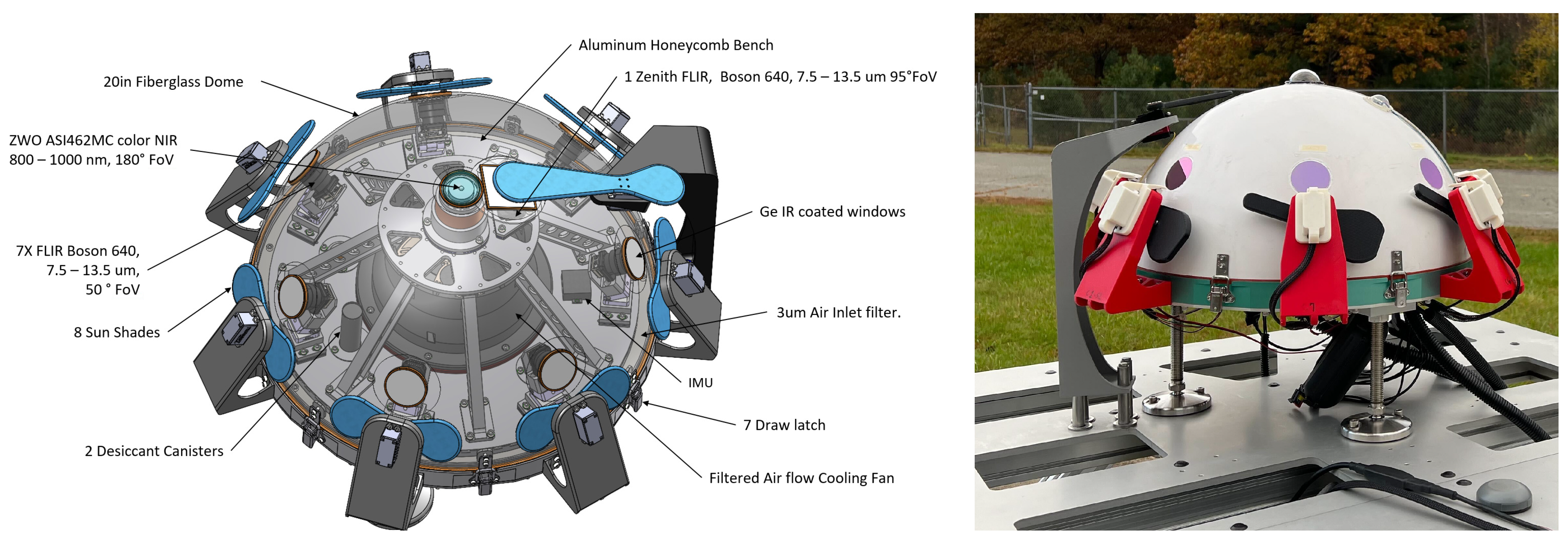



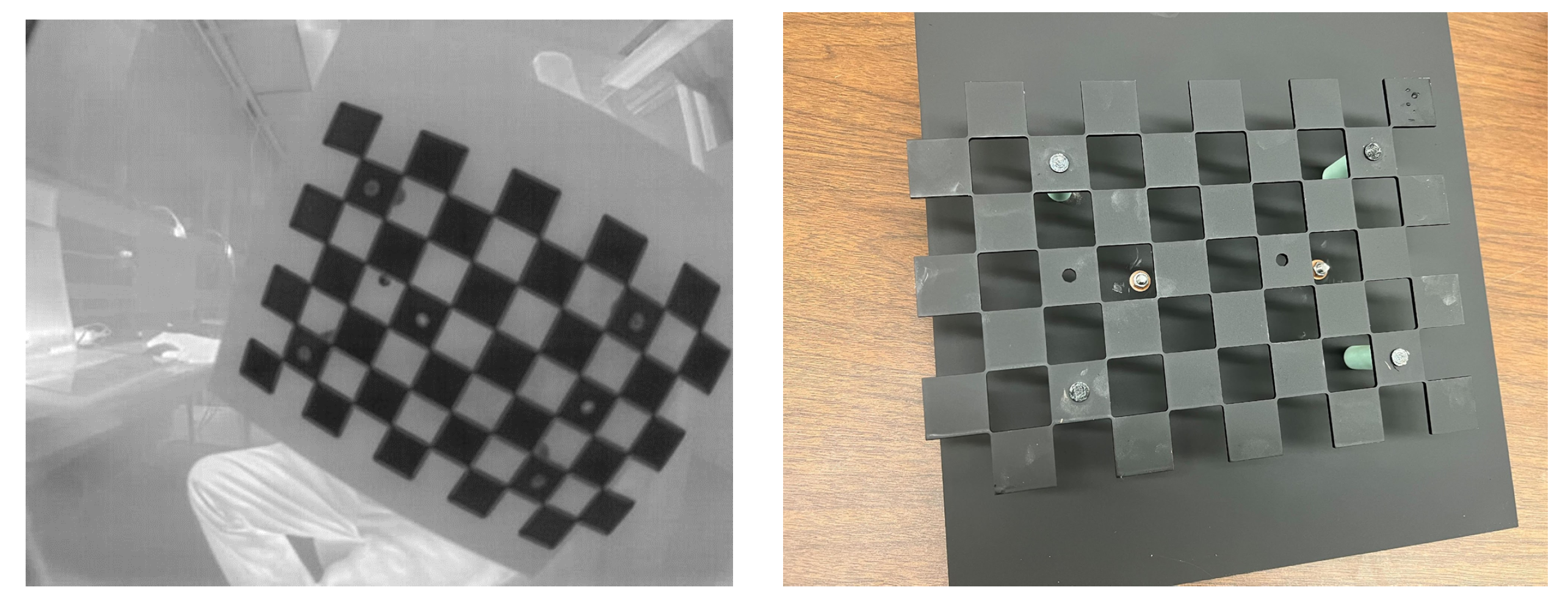
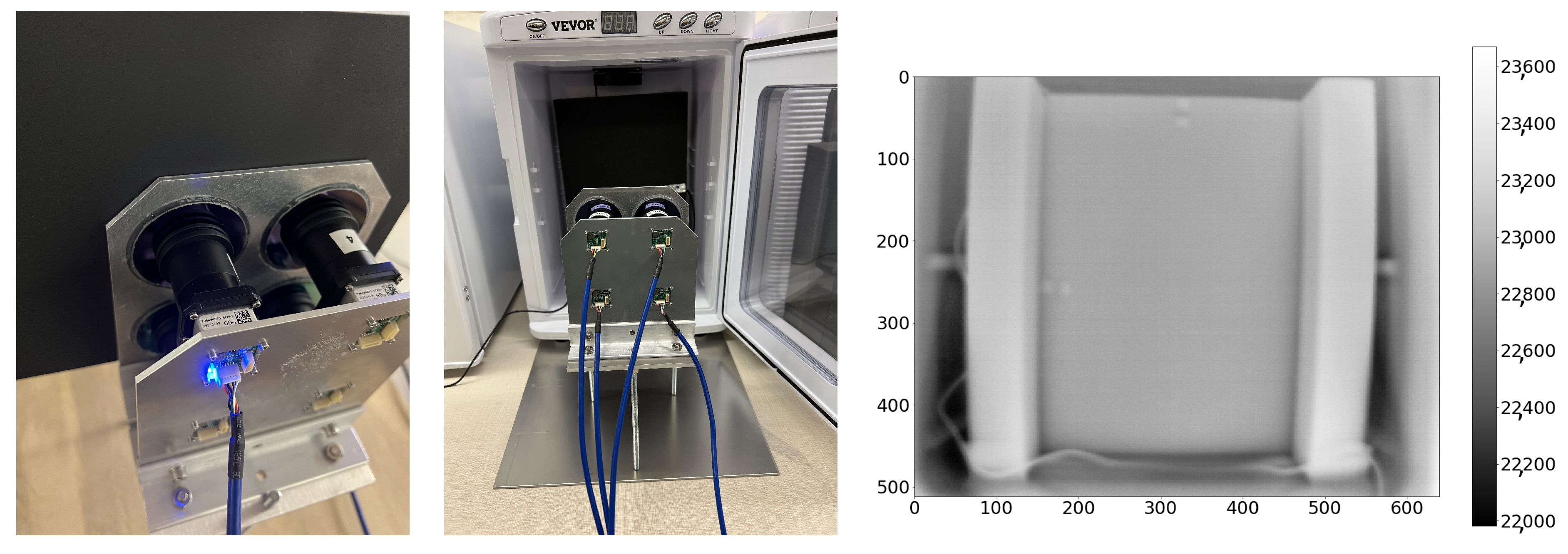
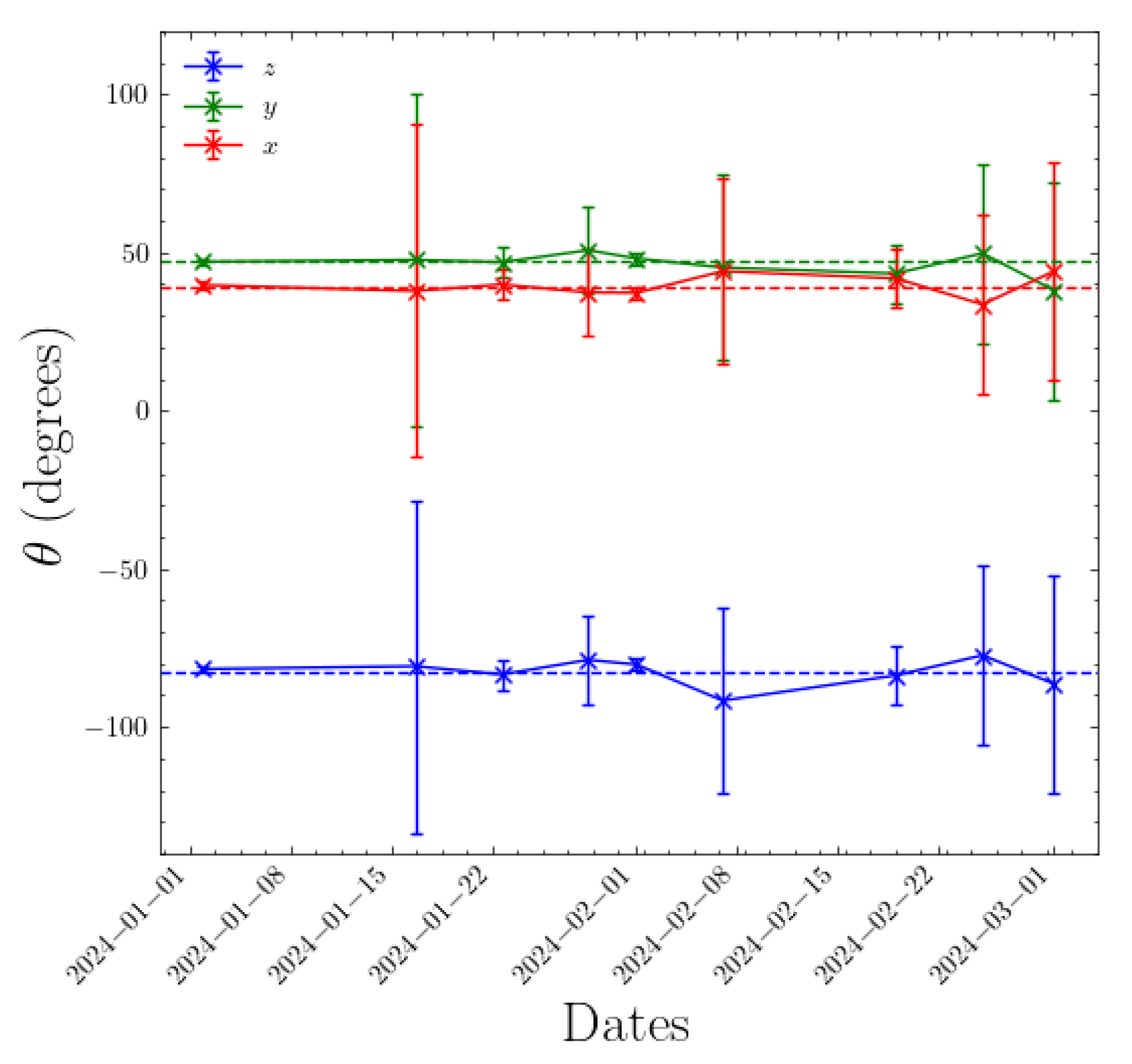








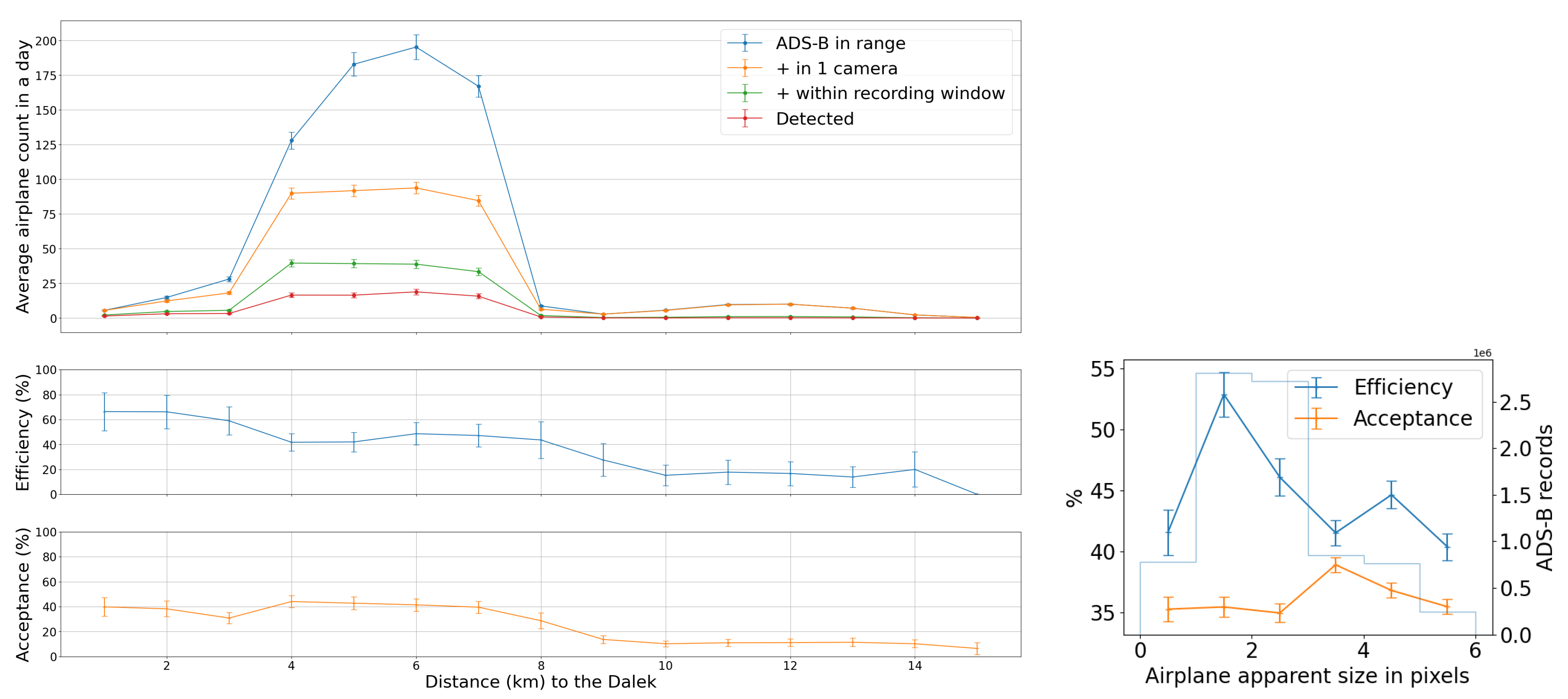


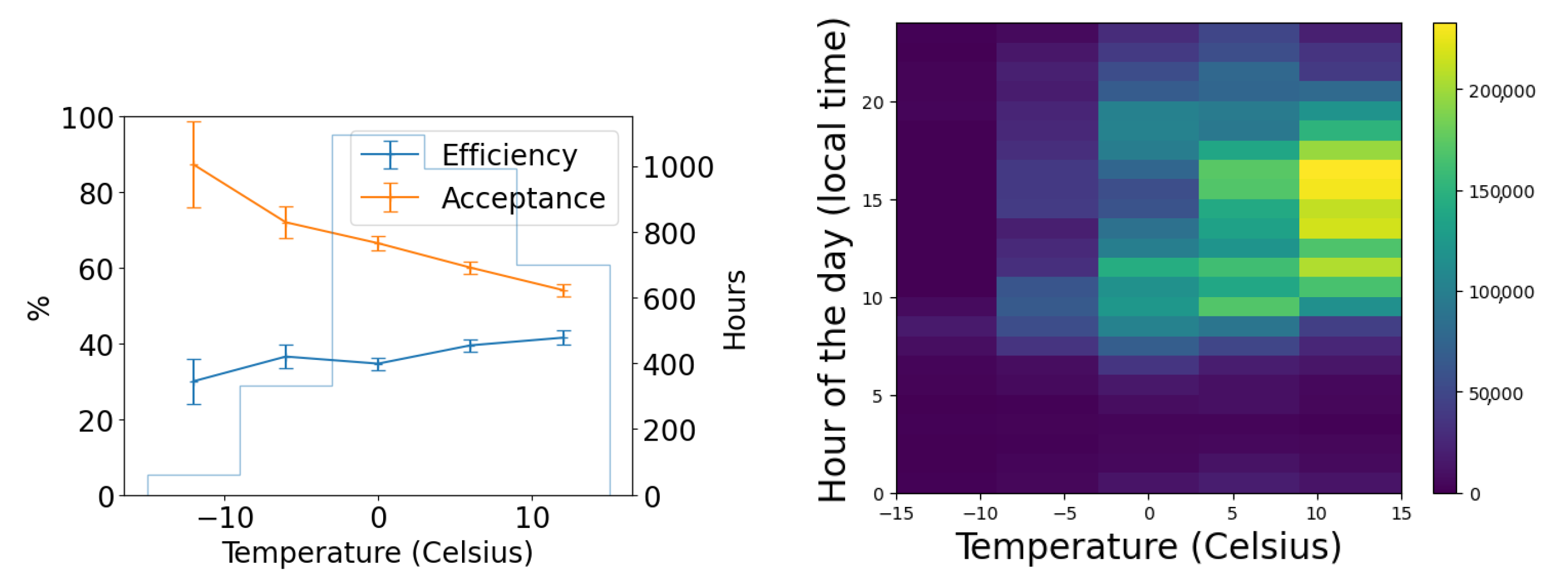

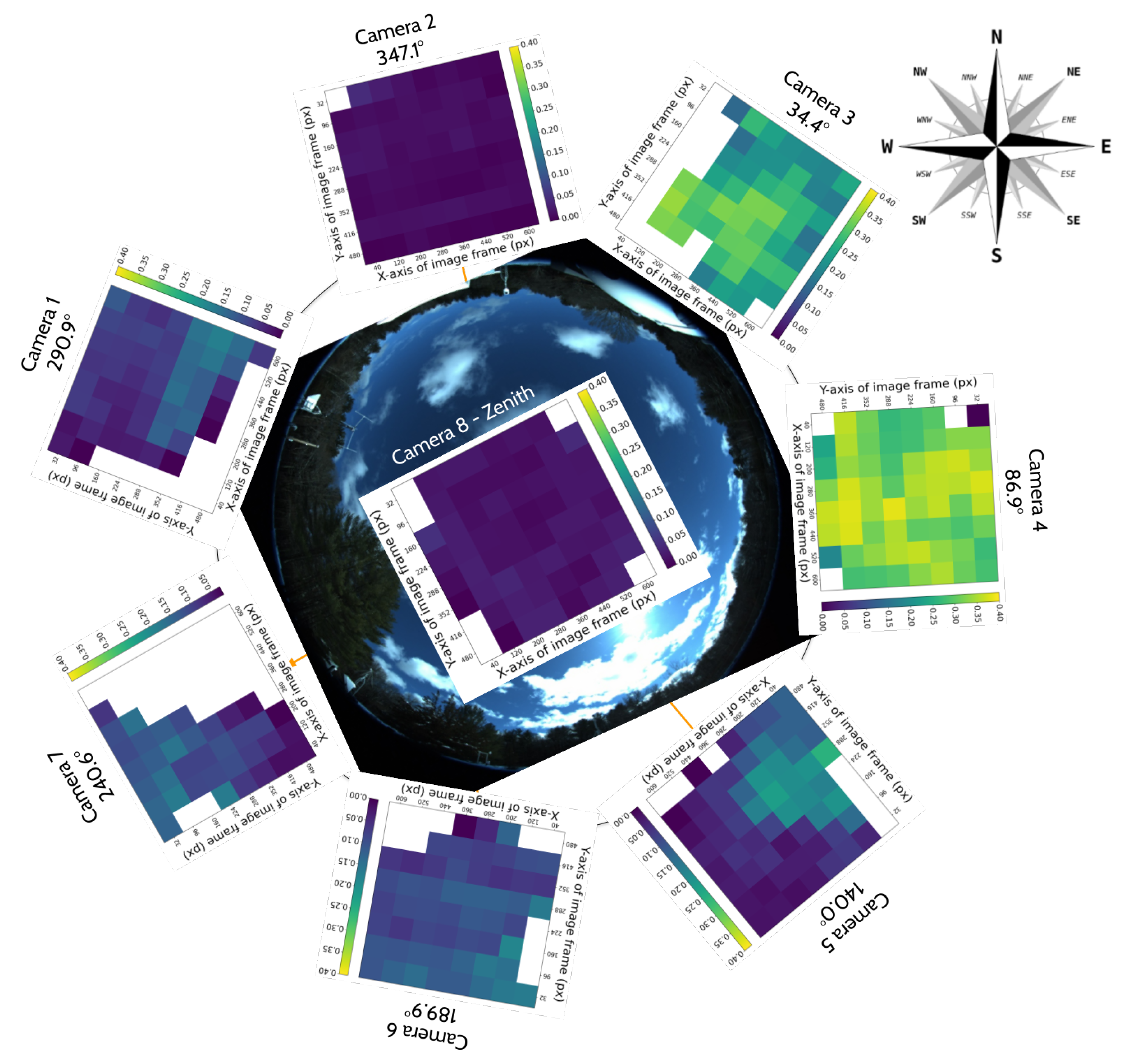





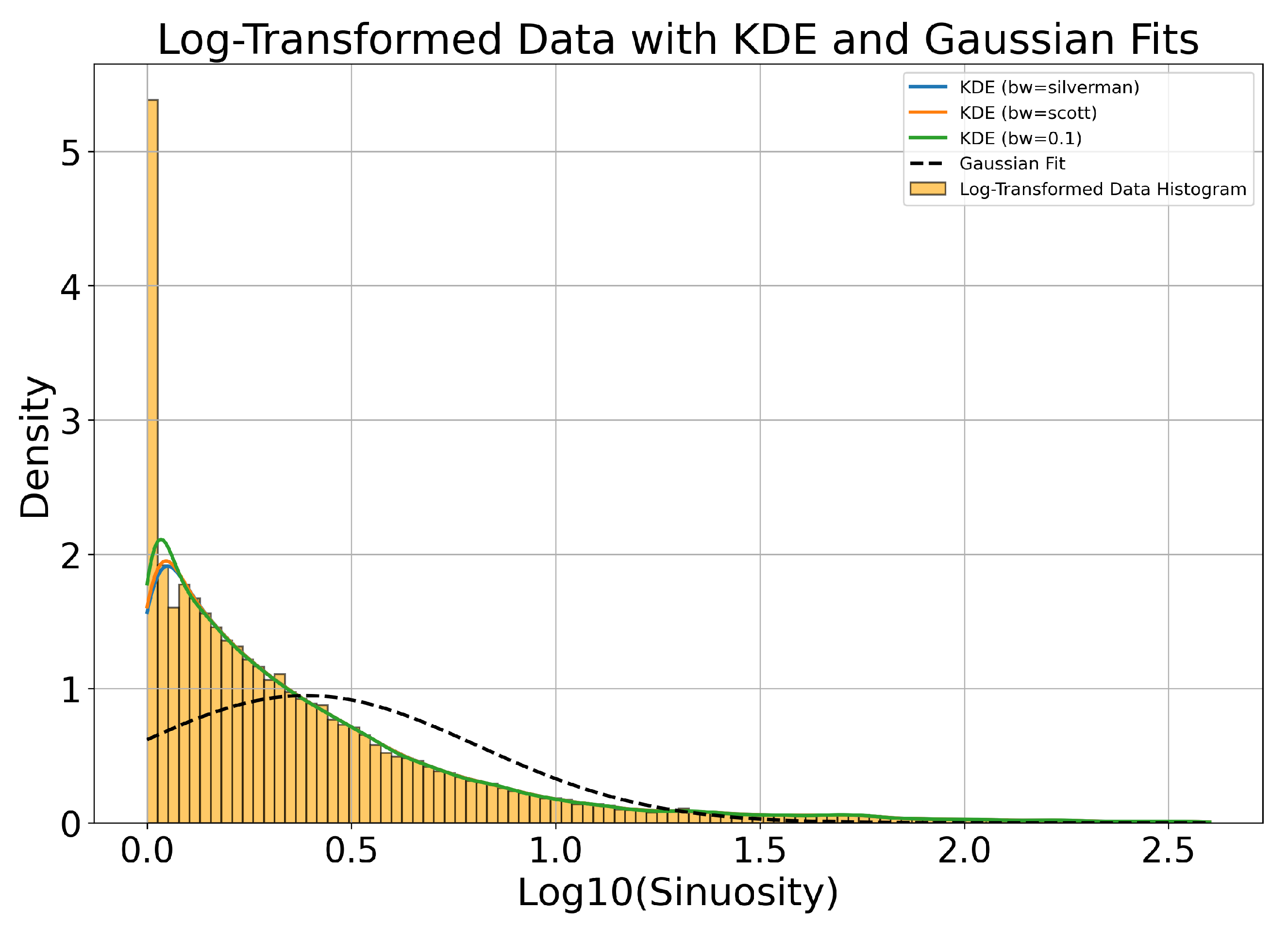
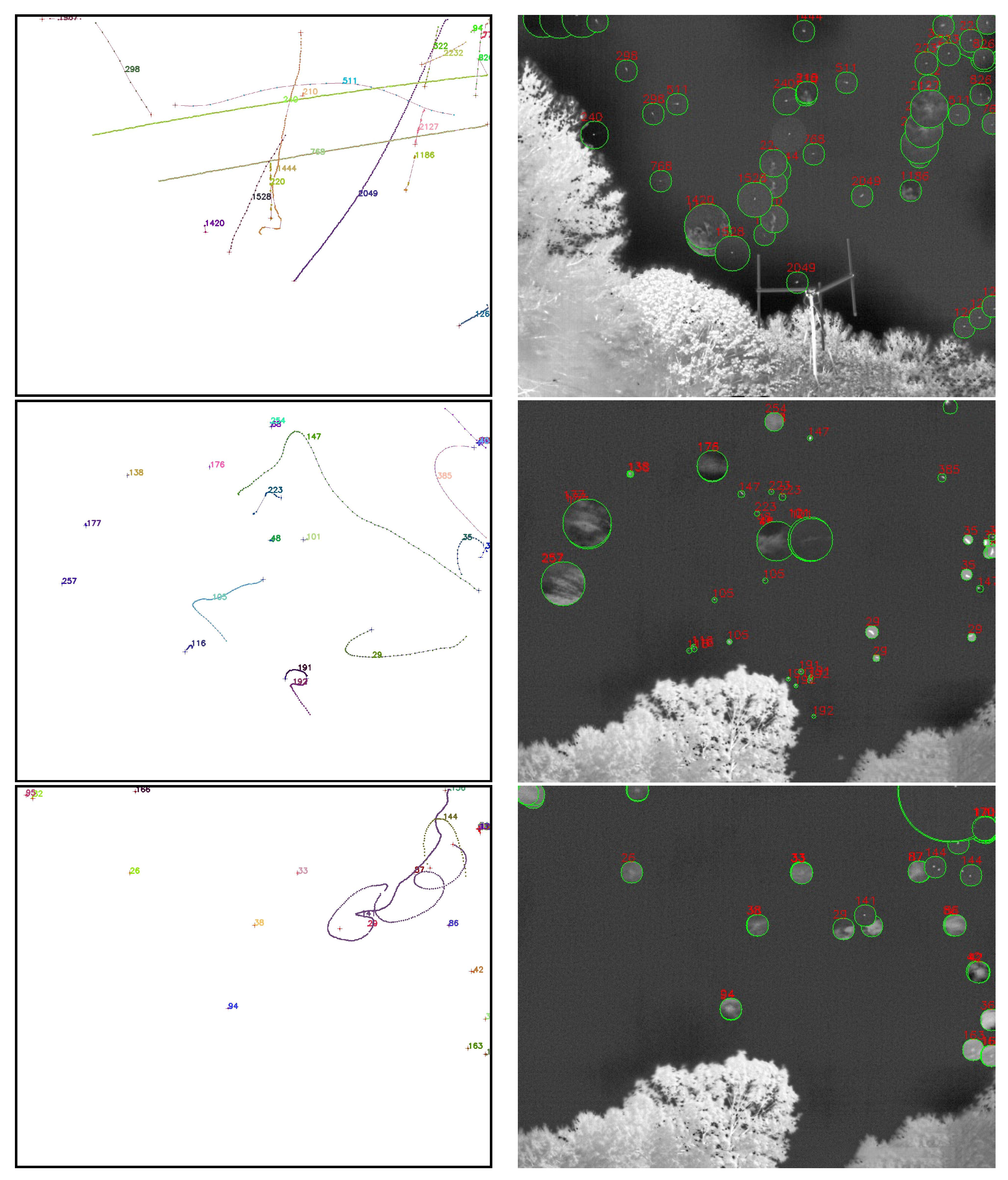

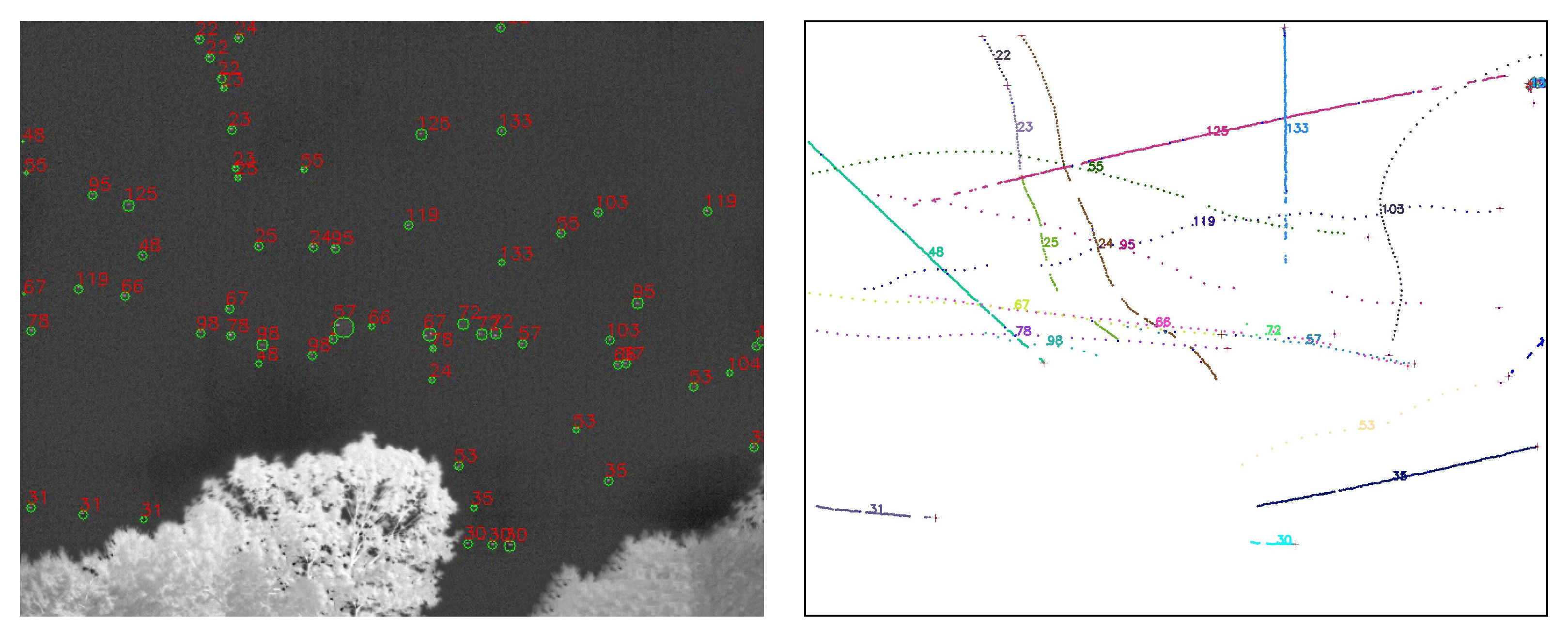
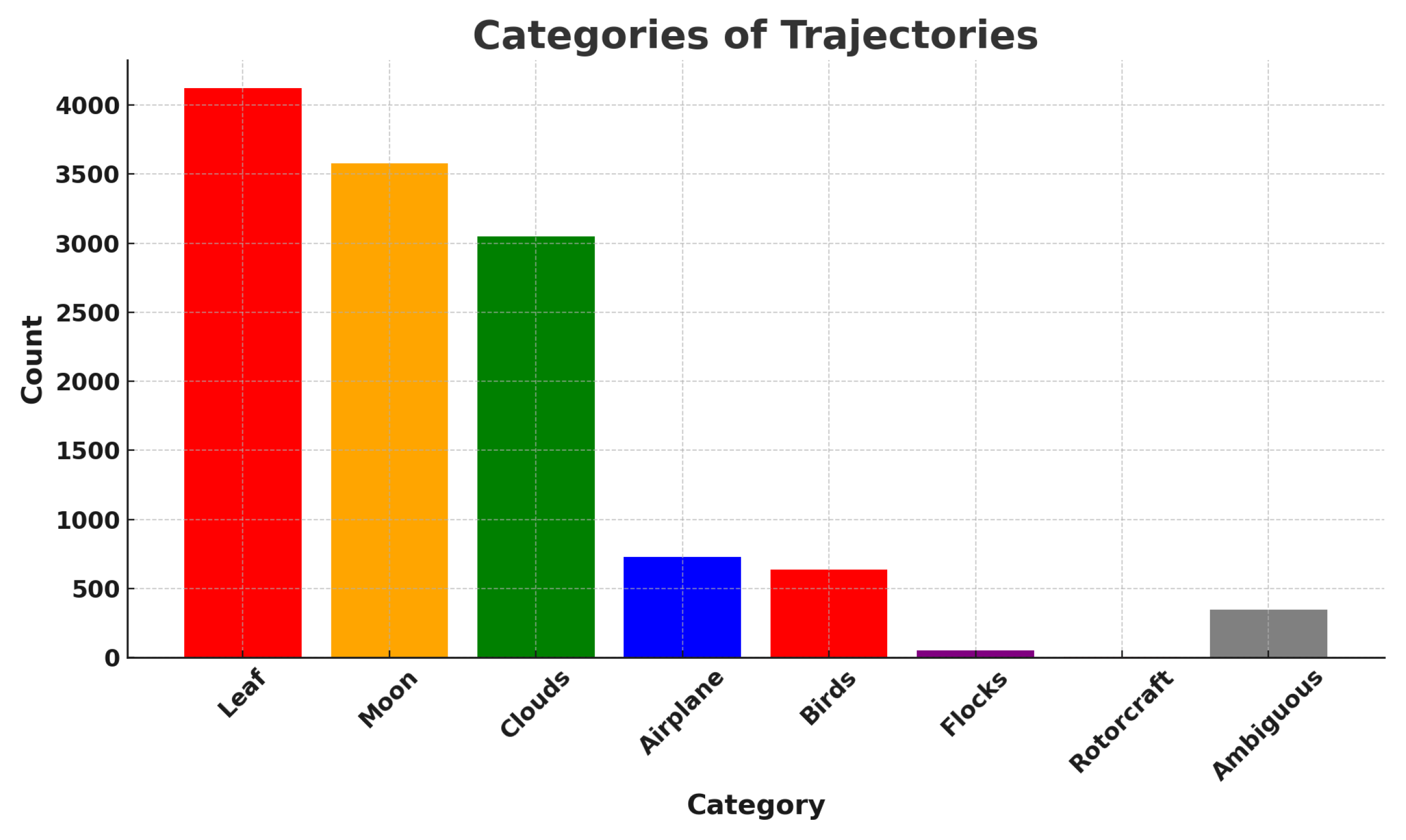
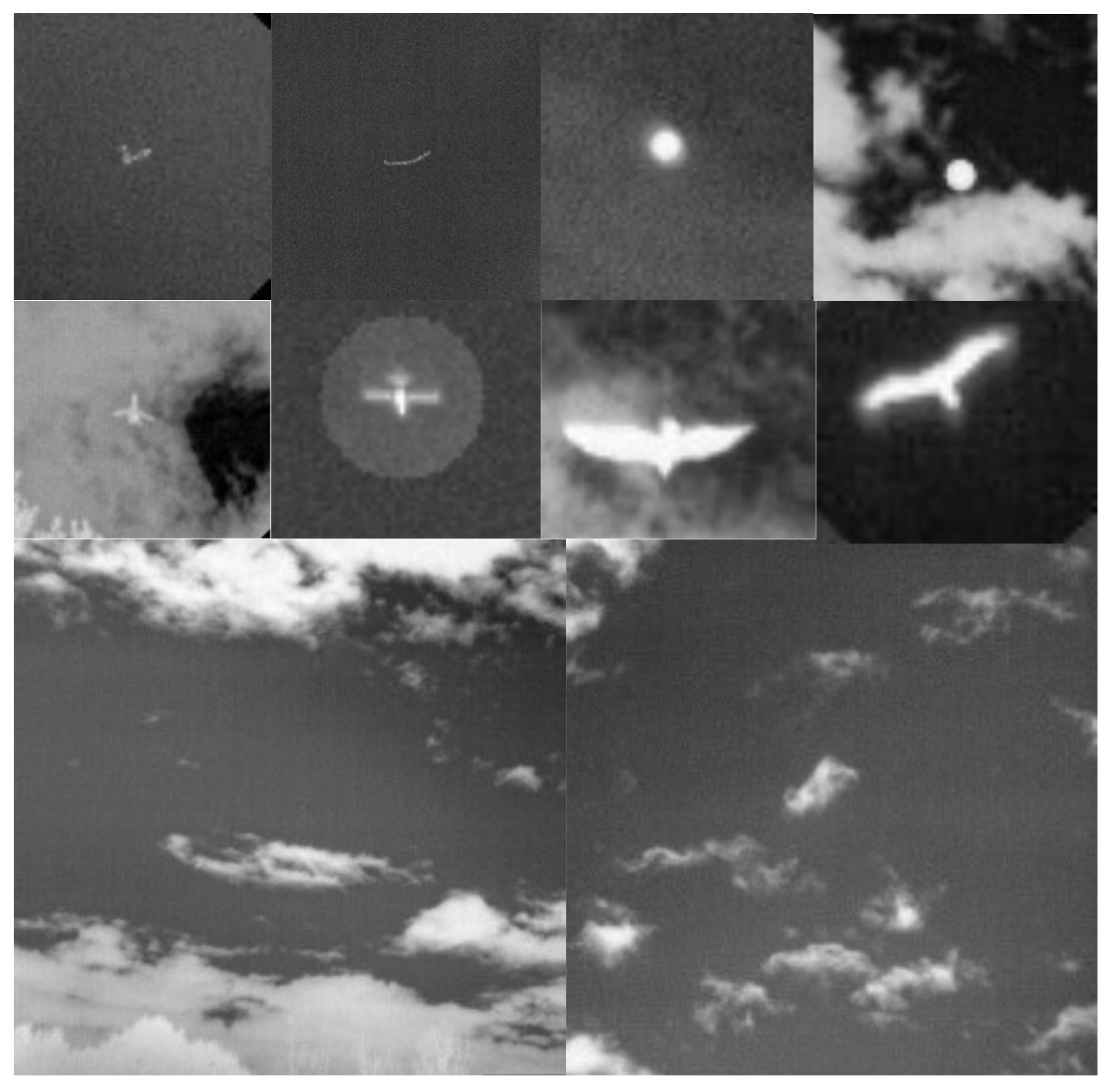
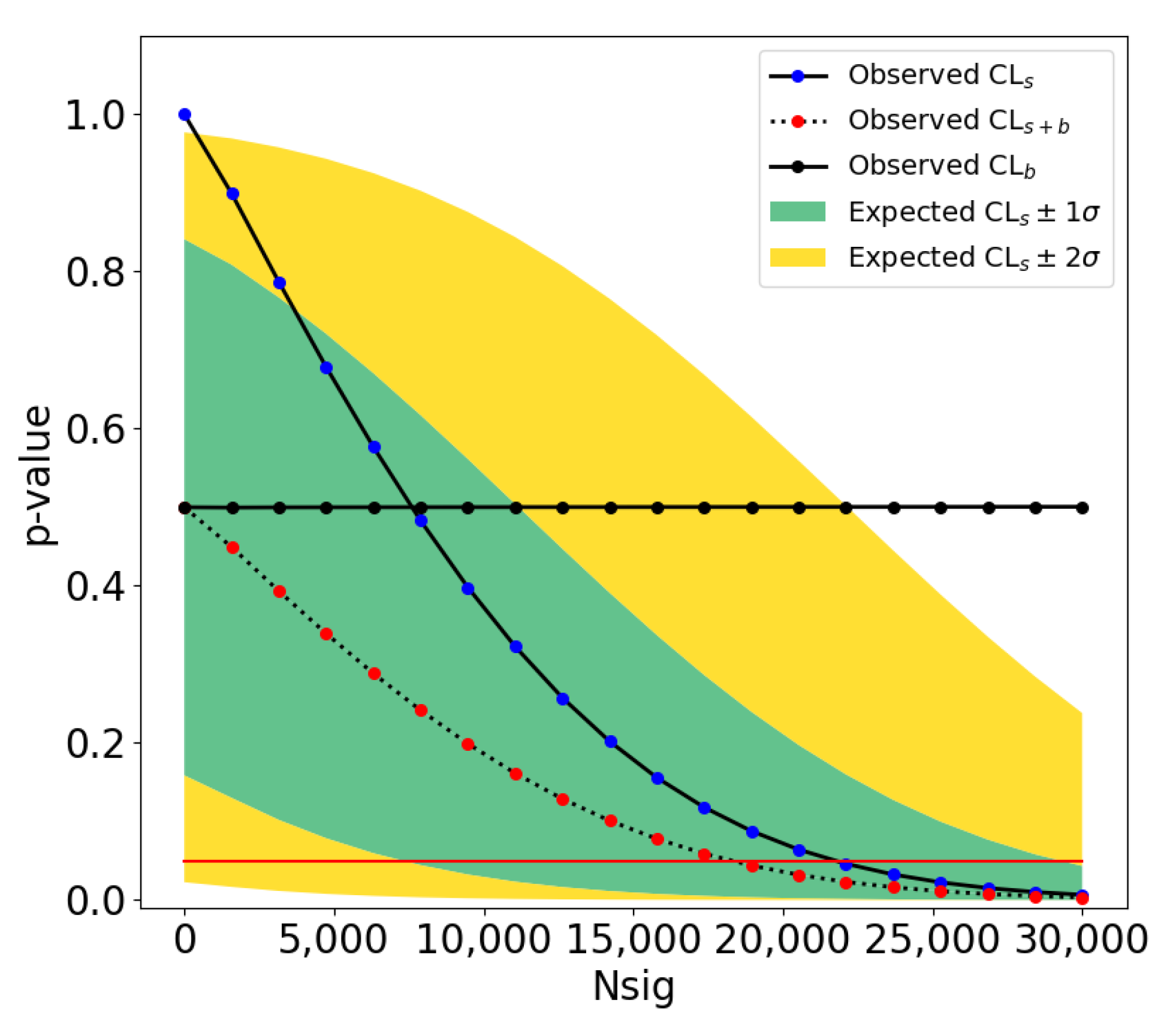
| Metric | Real-World + Synthetic Data | Synthetic-Only Data |
|---|---|---|
| True positive (TP) count | 2588 | 24,465 |
| False positive (FP) count | 435 | 8728 |
| False negative (FN) count | 36,412 | 14,535 |
| Precision | 85.6% | 73.7% |
| Recall | 6.60% | 62.7% |
| Accuracy | 6.60% | 51.3% |
| F1-score | 12.3% | 67.8% |
| Metric | Curved | Piecewise | Straight | All |
|---|---|---|---|---|
| FP count | 1757 | 1053 | 800 | 3610 |
| FN count | 9871 | 5208 | 3258 | 18,337 |
| Recall | 87% | 92% | 92% | 90% |
| Precision | 97% | 98% | 98% | 98% |
| IDS count | 122 | 149 | 15 | 286 |
| MOTA | 0.84 | 0.90 | 0.90 | 0.87 |
| MOTP | 0.14 | 0.13 | 0.14 | 0.14 |
| FM count | 380 | 353 | 202 | 935 |
| IDP | 95% | 94% | 97% | 95% |
| IDR | 85% | 88% | 91% | 87% |
| IDF1 | 89% | 91% | 94% | 91% |
| Trajectory Type | Curved | Straight | Piecewise |
|---|---|---|---|
| Unique true trajectories | ∼430 | ∼740 | ∼440 |
| Detection precision (fraction of detections which are matched to a true bounding box) | 50% | 41% | 51% |
| Detection recall (fraction of true bounding boxes which are matched to a detection) | 92% | 54% | 91% |
| Fraction of matched object detections without an associated reconstructed trajectory | 29% | 29% | 24% |
| Fraction of true trajectories which have at least one matched bounding box | 99.8% | 81% | 99% |
| Fraction of true trajectories which have at least one matched bounding box but no associated reconstructed trajectory | 7% | 15% | 5% |
| Efficiency (fraction of true trajectories matched to at least one reconstructed trajectory) | 94% | 74% | 96% |
| Purity (fraction of reconstructed trajectories matched to a true trajectory) | 90% | 83% | 90% |
| Model | Log-Likelihood on Test Data |
|---|---|
| KDE (bw = Silverman) | −1097.19 |
| KDE (bw = Scott) | −1020.60 |
| KDE (bw = 0.1) | −751.99 |
| Gaussian | −6860.76 |
Disclaimer/Publisher’s Note: The statements, opinions and data contained in all publications are solely those of the individual author(s) and contributor(s) and not of MDPI and/or the editor(s). MDPI and/or the editor(s) disclaim responsibility for any injury to people or property resulting from any ideas, methods, instructions or products referred to in the content. |
© 2025 by the authors. Licensee MDPI, Basel, Switzerland. This article is an open access article distributed under the terms and conditions of the Creative Commons Attribution (CC BY) license (https://creativecommons.org/licenses/by/4.0/).
Share and Cite
Domine, L.; Biswas, A.; Cloete, R.; Delacroix, A.; Fedorenko, A.; Jacaruso, L.; Kelderman, E.; Keto, E.; Little, S.; Loeb, A.; et al. Commissioning an All-Sky Infrared Camera Array for Detection of Airborne Objects. Sensors 2025, 25, 783. https://doi.org/10.3390/s25030783
Domine L, Biswas A, Cloete R, Delacroix A, Fedorenko A, Jacaruso L, Kelderman E, Keto E, Little S, Loeb A, et al. Commissioning an All-Sky Infrared Camera Array for Detection of Airborne Objects. Sensors. 2025; 25(3):783. https://doi.org/10.3390/s25030783
Chicago/Turabian StyleDomine, Laura, Ankit Biswas, Richard Cloete, Alex Delacroix, Andriy Fedorenko, Lucas Jacaruso, Ezra Kelderman, Eric Keto, Sarah Little, Abraham Loeb, and et al. 2025. "Commissioning an All-Sky Infrared Camera Array for Detection of Airborne Objects" Sensors 25, no. 3: 783. https://doi.org/10.3390/s25030783
APA StyleDomine, L., Biswas, A., Cloete, R., Delacroix, A., Fedorenko, A., Jacaruso, L., Kelderman, E., Keto, E., Little, S., Loeb, A., Masson, E., Prior, M., Schultz, F., Szenher, M., Watters, W. A., & White, A. (2025). Commissioning an All-Sky Infrared Camera Array for Detection of Airborne Objects. Sensors, 25(3), 783. https://doi.org/10.3390/s25030783







